International Finance: Big Mac PPP, Currency Valuation Analysis Report
VerifiedAdded on 2020/04/21
|13
|2916
|272
Report
AI Summary
This report delves into the realm of international finance, focusing on the Purchasing Power Parity (PPP) concept, particularly as it relates to the Big Mac Index. The report begins by defining PPP and exploring the factors that influence it, as well as its inherent limitations. It then proceeds to analyze ...
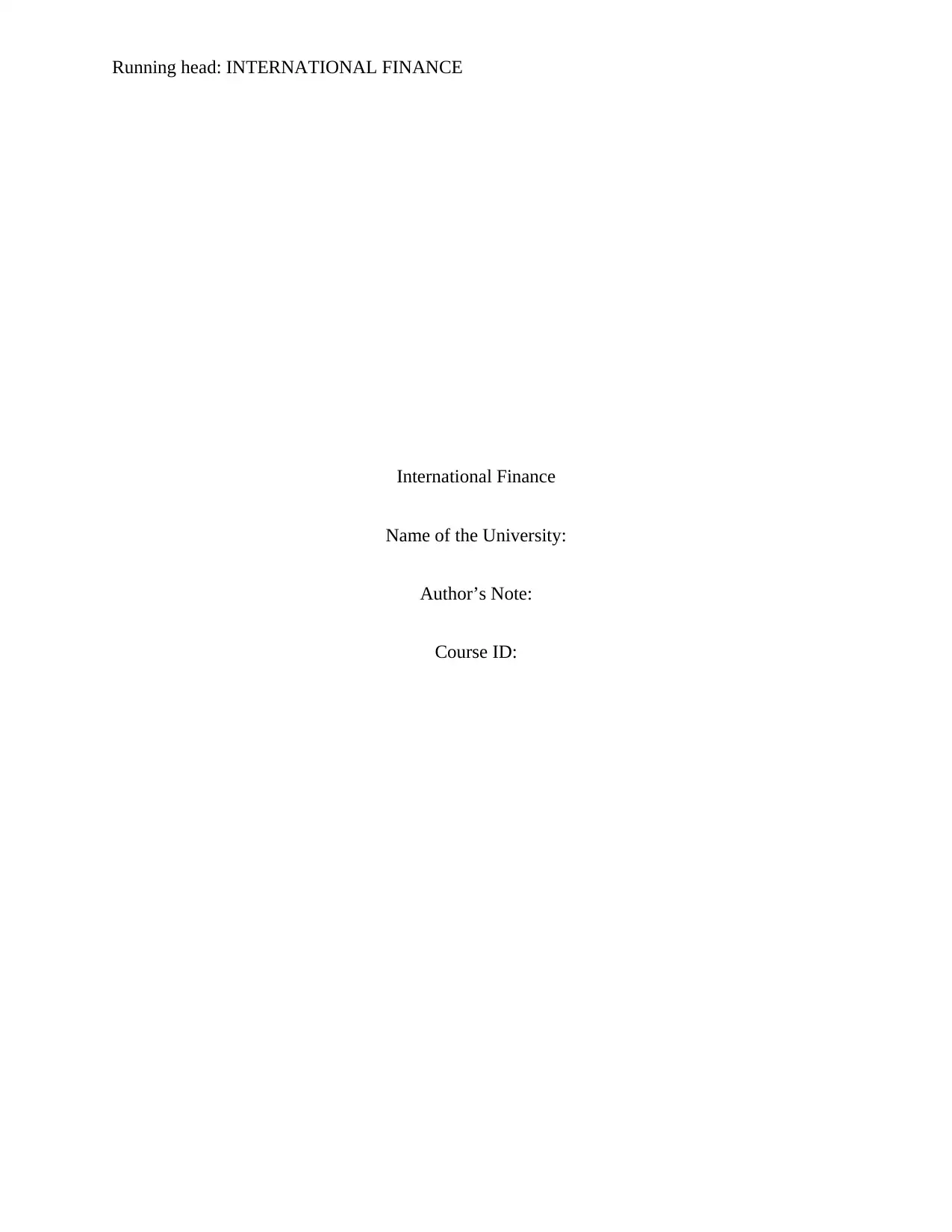
Running head: INTERNATIONAL FINANCE
International Finance
Name of the University:
Author’s Note:
Course ID:
International Finance
Name of the University:
Author’s Note:
Course ID:
Paraphrase This Document
Need a fresh take? Get an instant paraphrase of this document with our AI Paraphraser
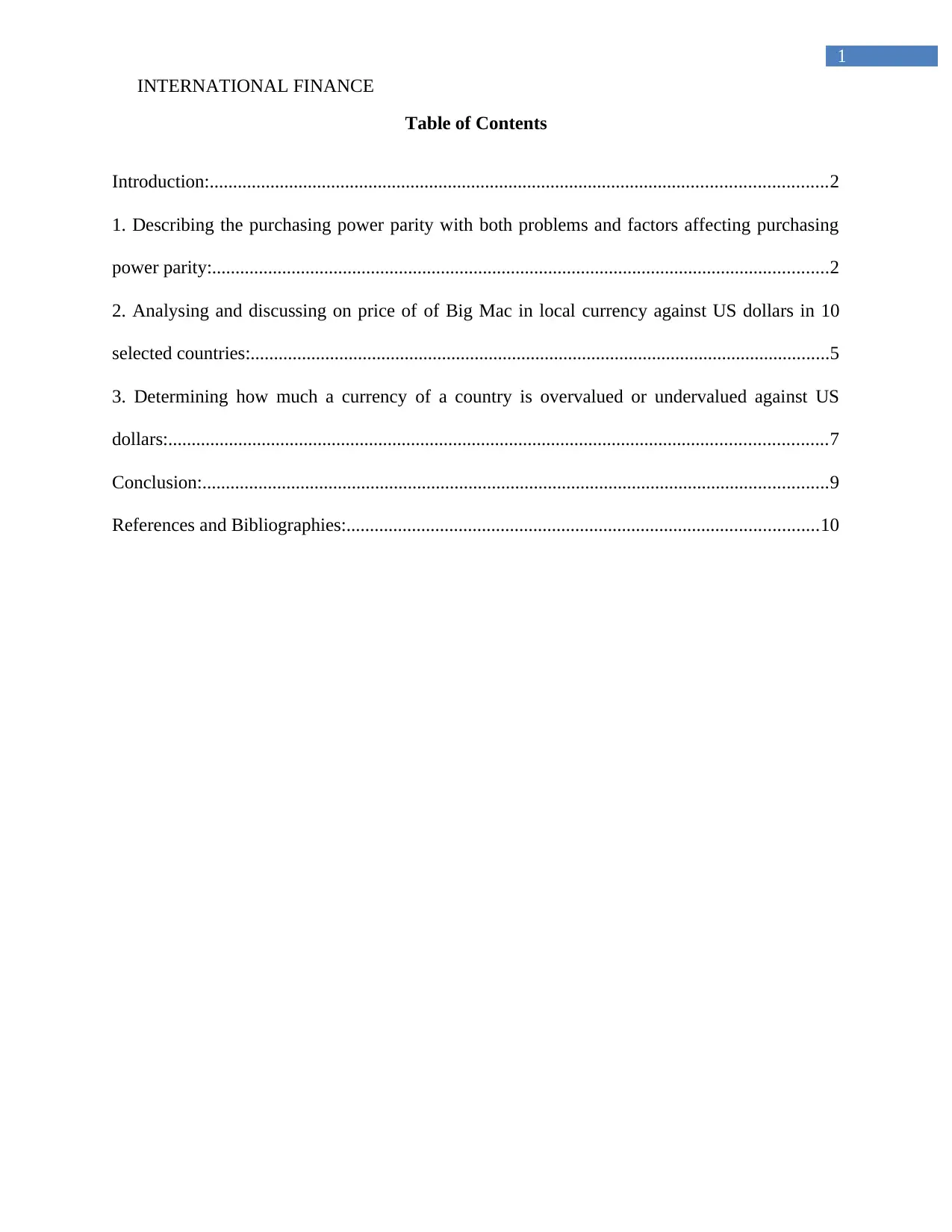
1
INTERNATIONAL FINANCE
Table of Contents
Introduction:....................................................................................................................................2
1. Describing the purchasing power parity with both problems and factors affecting purchasing
power parity:....................................................................................................................................2
2. Analysing and discussing on price of of Big Mac in local currency against US dollars in 10
selected countries:............................................................................................................................5
3. Determining how much a currency of a country is overvalued or undervalued against US
dollars:.............................................................................................................................................7
Conclusion:......................................................................................................................................9
References and Bibliographies:.....................................................................................................10
INTERNATIONAL FINANCE
Table of Contents
Introduction:....................................................................................................................................2
1. Describing the purchasing power parity with both problems and factors affecting purchasing
power parity:....................................................................................................................................2
2. Analysing and discussing on price of of Big Mac in local currency against US dollars in 10
selected countries:............................................................................................................................5
3. Determining how much a currency of a country is overvalued or undervalued against US
dollars:.............................................................................................................................................7
Conclusion:......................................................................................................................................9
References and Bibliographies:.....................................................................................................10
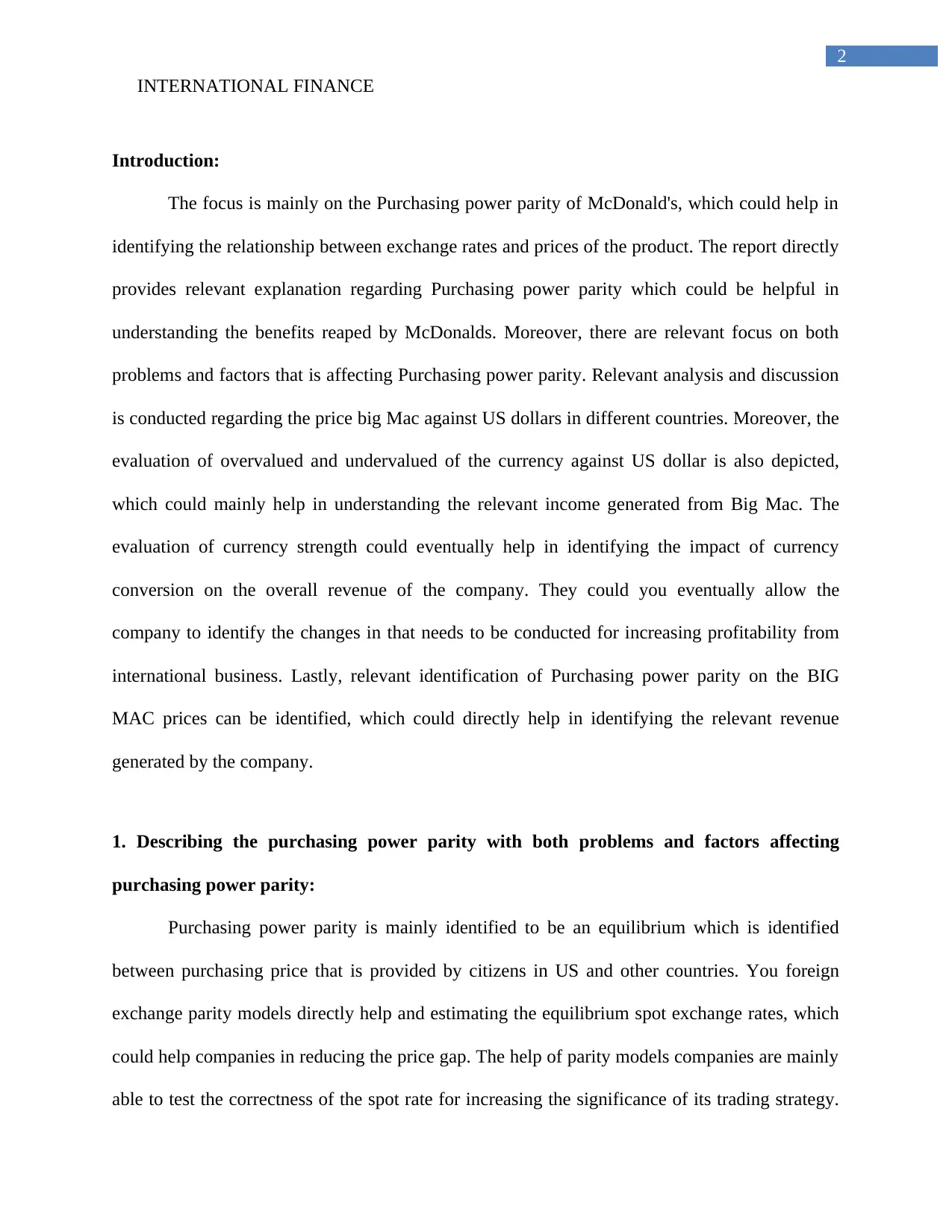
2
INTERNATIONAL FINANCE
Introduction:
The focus is mainly on the Purchasing power parity of McDonald's, which could help in
identifying the relationship between exchange rates and prices of the product. The report directly
provides relevant explanation regarding Purchasing power parity which could be helpful in
understanding the benefits reaped by McDonalds. Moreover, there are relevant focus on both
problems and factors that is affecting Purchasing power parity. Relevant analysis and discussion
is conducted regarding the price big Mac against US dollars in different countries. Moreover, the
evaluation of overvalued and undervalued of the currency against US dollar is also depicted,
which could mainly help in understanding the relevant income generated from Big Mac. The
evaluation of currency strength could eventually help in identifying the impact of currency
conversion on the overall revenue of the company. They could you eventually allow the
company to identify the changes in that needs to be conducted for increasing profitability from
international business. Lastly, relevant identification of Purchasing power parity on the BIG
MAC prices can be identified, which could directly help in identifying the relevant revenue
generated by the company.
1. Describing the purchasing power parity with both problems and factors affecting
purchasing power parity:
Purchasing power parity is mainly identified to be an equilibrium which is identified
between purchasing price that is provided by citizens in US and other countries. You foreign
exchange parity models directly help and estimating the equilibrium spot exchange rates, which
could help companies in reducing the price gap. The help of parity models companies are mainly
able to test the correctness of the spot rate for increasing the significance of its trading strategy.
INTERNATIONAL FINANCE
Introduction:
The focus is mainly on the Purchasing power parity of McDonald's, which could help in
identifying the relationship between exchange rates and prices of the product. The report directly
provides relevant explanation regarding Purchasing power parity which could be helpful in
understanding the benefits reaped by McDonalds. Moreover, there are relevant focus on both
problems and factors that is affecting Purchasing power parity. Relevant analysis and discussion
is conducted regarding the price big Mac against US dollars in different countries. Moreover, the
evaluation of overvalued and undervalued of the currency against US dollar is also depicted,
which could mainly help in understanding the relevant income generated from Big Mac. The
evaluation of currency strength could eventually help in identifying the impact of currency
conversion on the overall revenue of the company. They could you eventually allow the
company to identify the changes in that needs to be conducted for increasing profitability from
international business. Lastly, relevant identification of Purchasing power parity on the BIG
MAC prices can be identified, which could directly help in identifying the relevant revenue
generated by the company.
1. Describing the purchasing power parity with both problems and factors affecting
purchasing power parity:
Purchasing power parity is mainly identified to be an equilibrium which is identified
between purchasing price that is provided by citizens in US and other countries. You foreign
exchange parity models directly help and estimating the equilibrium spot exchange rates, which
could help companies in reducing the price gap. The help of parity models companies are mainly
able to test the correctness of the spot rate for increasing the significance of its trading strategy.
⊘ This is a preview!⊘
Do you want full access?
Subscribe today to unlock all pages.

Trusted by 1+ million students worldwide
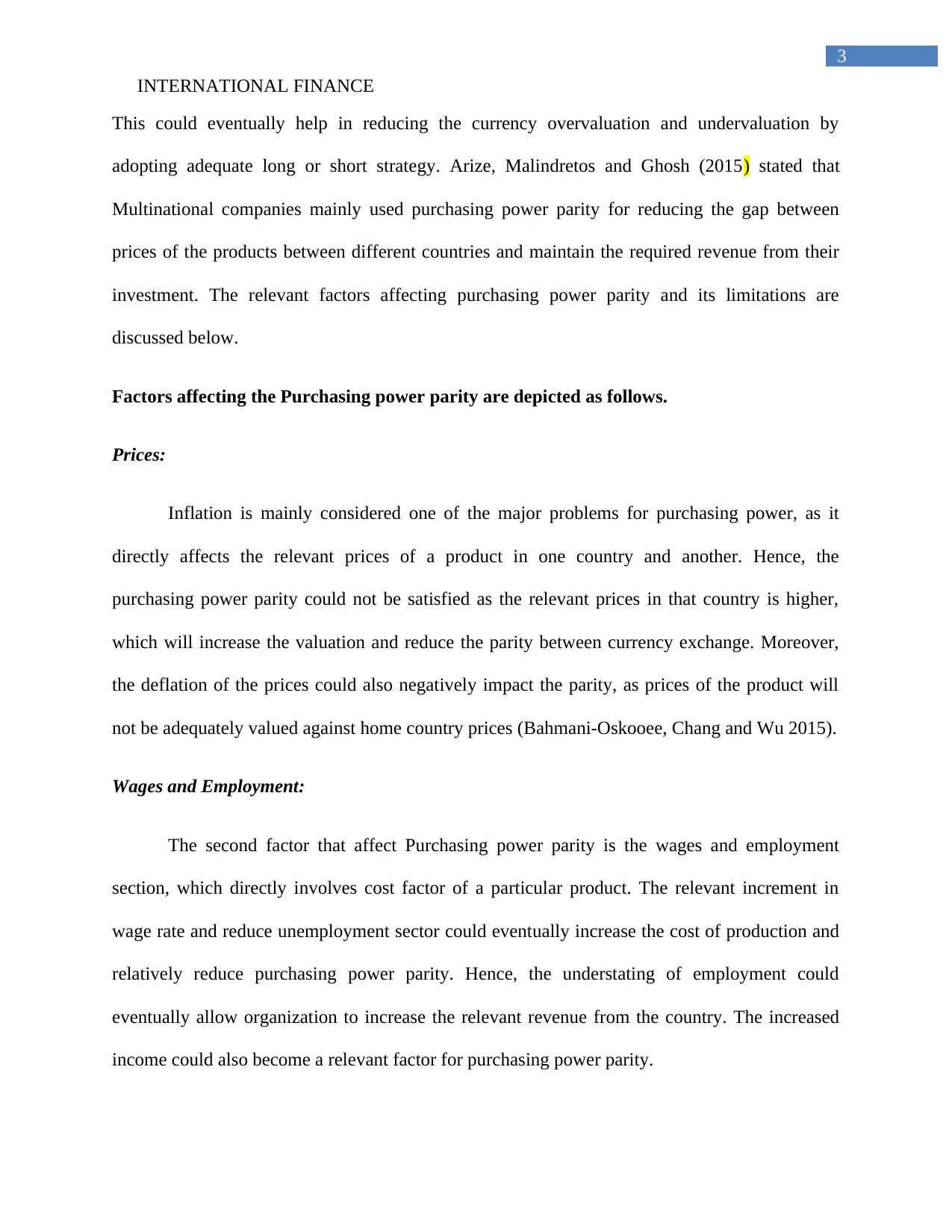
3
INTERNATIONAL FINANCE
This could eventually help in reducing the currency overvaluation and undervaluation by
adopting adequate long or short strategy. Arize, Malindretos and Ghosh (2015) stated that
Multinational companies mainly used purchasing power parity for reducing the gap between
prices of the products between different countries and maintain the required revenue from their
investment. The relevant factors affecting purchasing power parity and its limitations are
discussed below.
Factors affecting the Purchasing power parity are depicted as follows.
Prices:
Inflation is mainly considered one of the major problems for purchasing power, as it
directly affects the relevant prices of a product in one country and another. Hence, the
purchasing power parity could not be satisfied as the relevant prices in that country is higher,
which will increase the valuation and reduce the parity between currency exchange. Moreover,
the deflation of the prices could also negatively impact the parity, as prices of the product will
not be adequately valued against home country prices (Bahmani-Oskooee, Chang and Wu 2015).
Wages and Employment:
The second factor that affect Purchasing power parity is the wages and employment
section, which directly involves cost factor of a particular product. The relevant increment in
wage rate and reduce unemployment sector could eventually increase the cost of production and
relatively reduce purchasing power parity. Hence, the understating of employment could
eventually allow organization to increase the relevant revenue from the country. The increased
income could also become a relevant factor for purchasing power parity.
INTERNATIONAL FINANCE
This could eventually help in reducing the currency overvaluation and undervaluation by
adopting adequate long or short strategy. Arize, Malindretos and Ghosh (2015) stated that
Multinational companies mainly used purchasing power parity for reducing the gap between
prices of the products between different countries and maintain the required revenue from their
investment. The relevant factors affecting purchasing power parity and its limitations are
discussed below.
Factors affecting the Purchasing power parity are depicted as follows.
Prices:
Inflation is mainly considered one of the major problems for purchasing power, as it
directly affects the relevant prices of a product in one country and another. Hence, the
purchasing power parity could not be satisfied as the relevant prices in that country is higher,
which will increase the valuation and reduce the parity between currency exchange. Moreover,
the deflation of the prices could also negatively impact the parity, as prices of the product will
not be adequately valued against home country prices (Bahmani-Oskooee, Chang and Wu 2015).
Wages and Employment:
The second factor that affect Purchasing power parity is the wages and employment
section, which directly involves cost factor of a particular product. The relevant increment in
wage rate and reduce unemployment sector could eventually increase the cost of production and
relatively reduce purchasing power parity. Hence, the understating of employment could
eventually allow organization to increase the relevant revenue from the country. The increased
income could also become a relevant factor for purchasing power parity.
Paraphrase This Document
Need a fresh take? Get an instant paraphrase of this document with our AI Paraphraser
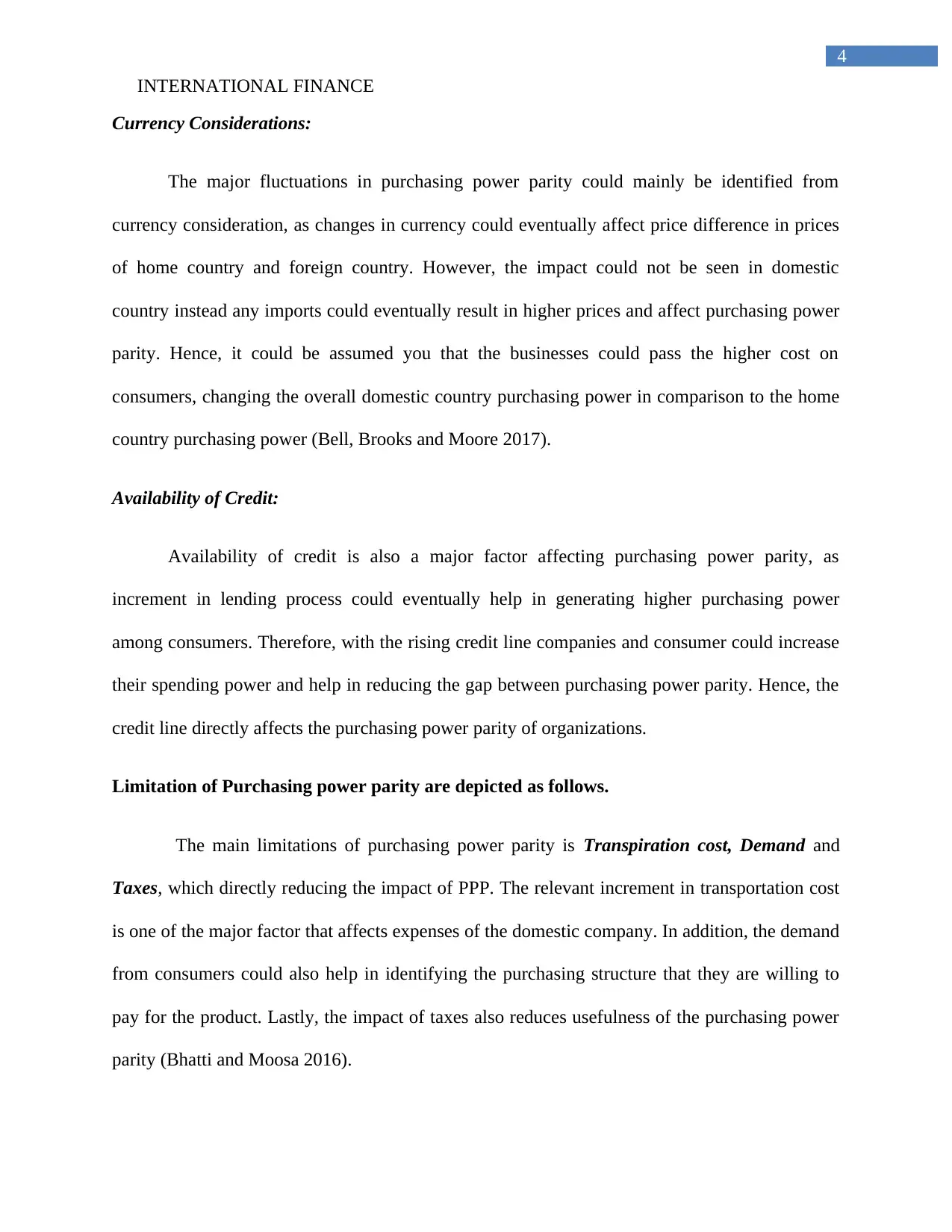
4
INTERNATIONAL FINANCE
Currency Considerations:
The major fluctuations in purchasing power parity could mainly be identified from
currency consideration, as changes in currency could eventually affect price difference in prices
of home country and foreign country. However, the impact could not be seen in domestic
country instead any imports could eventually result in higher prices and affect purchasing power
parity. Hence, it could be assumed you that the businesses could pass the higher cost on
consumers, changing the overall domestic country purchasing power in comparison to the home
country purchasing power (Bell, Brooks and Moore 2017).
Availability of Credit:
Availability of credit is also a major factor affecting purchasing power parity, as
increment in lending process could eventually help in generating higher purchasing power
among consumers. Therefore, with the rising credit line companies and consumer could increase
their spending power and help in reducing the gap between purchasing power parity. Hence, the
credit line directly affects the purchasing power parity of organizations.
Limitation of Purchasing power parity are depicted as follows.
The main limitations of purchasing power parity is Transpiration cost, Demand and
Taxes, which directly reducing the impact of PPP. The relevant increment in transportation cost
is one of the major factor that affects expenses of the domestic company. In addition, the demand
from consumers could also help in identifying the purchasing structure that they are willing to
pay for the product. Lastly, the impact of taxes also reduces usefulness of the purchasing power
parity (Bhatti and Moosa 2016).
INTERNATIONAL FINANCE
Currency Considerations:
The major fluctuations in purchasing power parity could mainly be identified from
currency consideration, as changes in currency could eventually affect price difference in prices
of home country and foreign country. However, the impact could not be seen in domestic
country instead any imports could eventually result in higher prices and affect purchasing power
parity. Hence, it could be assumed you that the businesses could pass the higher cost on
consumers, changing the overall domestic country purchasing power in comparison to the home
country purchasing power (Bell, Brooks and Moore 2017).
Availability of Credit:
Availability of credit is also a major factor affecting purchasing power parity, as
increment in lending process could eventually help in generating higher purchasing power
among consumers. Therefore, with the rising credit line companies and consumer could increase
their spending power and help in reducing the gap between purchasing power parity. Hence, the
credit line directly affects the purchasing power parity of organizations.
Limitation of Purchasing power parity are depicted as follows.
The main limitations of purchasing power parity is Transpiration cost, Demand and
Taxes, which directly reducing the impact of PPP. The relevant increment in transportation cost
is one of the major factor that affects expenses of the domestic company. In addition, the demand
from consumers could also help in identifying the purchasing structure that they are willing to
pay for the product. Lastly, the impact of taxes also reduces usefulness of the purchasing power
parity (Bhatti and Moosa 2016).
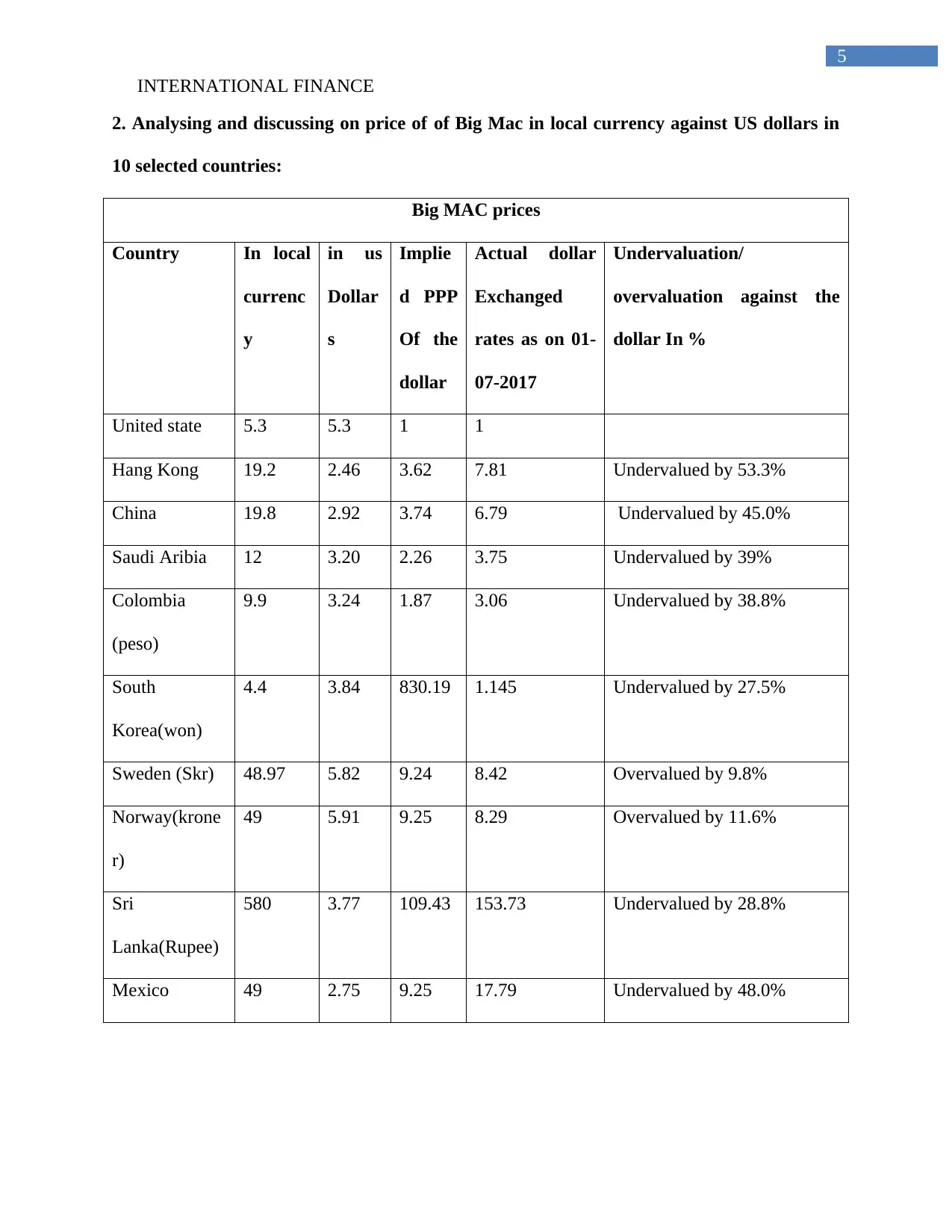
5
INTERNATIONAL FINANCE
2. Analysing and discussing on price of of Big Mac in local currency against US dollars in
10 selected countries:
Big MAC prices
Country In local
currenc
y
in us
Dollar
s
Implie
d PPP
Of the
dollar
Actual dollar
Exchanged
rates as on 01-
07-2017
Undervaluation/
overvaluation against the
dollar In %
United state 5.3 5.3 1 1
Hang Kong 19.2 2.46 3.62 7.81 Undervalued by 53.3%
China 19.8 2.92 3.74 6.79 Undervalued by 45.0%
Saudi Aribia 12 3.20 2.26 3.75 Undervalued by 39%
Colombia
(peso)
9.9 3.24 1.87 3.06 Undervalued by 38.8%
South
Korea(won)
4.4 3.84 830.19 1.145 Undervalued by 27.5%
Sweden (Skr) 48.97 5.82 9.24 8.42 Overvalued by 9.8%
Norway(krone
r)
49 5.91 9.25 8.29 Overvalued by 11.6%
Sri
Lanka(Rupee)
580 3.77 109.43 153.73 Undervalued by 28.8%
Mexico 49 2.75 9.25 17.79 Undervalued by 48.0%
INTERNATIONAL FINANCE
2. Analysing and discussing on price of of Big Mac in local currency against US dollars in
10 selected countries:
Big MAC prices
Country In local
currenc
y
in us
Dollar
s
Implie
d PPP
Of the
dollar
Actual dollar
Exchanged
rates as on 01-
07-2017
Undervaluation/
overvaluation against the
dollar In %
United state 5.3 5.3 1 1
Hang Kong 19.2 2.46 3.62 7.81 Undervalued by 53.3%
China 19.8 2.92 3.74 6.79 Undervalued by 45.0%
Saudi Aribia 12 3.20 2.26 3.75 Undervalued by 39%
Colombia
(peso)
9.9 3.24 1.87 3.06 Undervalued by 38.8%
South
Korea(won)
4.4 3.84 830.19 1.145 Undervalued by 27.5%
Sweden (Skr) 48.97 5.82 9.24 8.42 Overvalued by 9.8%
Norway(krone
r)
49 5.91 9.25 8.29 Overvalued by 11.6%
Sri
Lanka(Rupee)
580 3.77 109.43 153.73 Undervalued by 28.8%
Mexico 49 2.75 9.25 17.79 Undervalued by 48.0%
⊘ This is a preview!⊘
Do you want full access?
Subscribe today to unlock all pages.

Trusted by 1+ million students worldwide
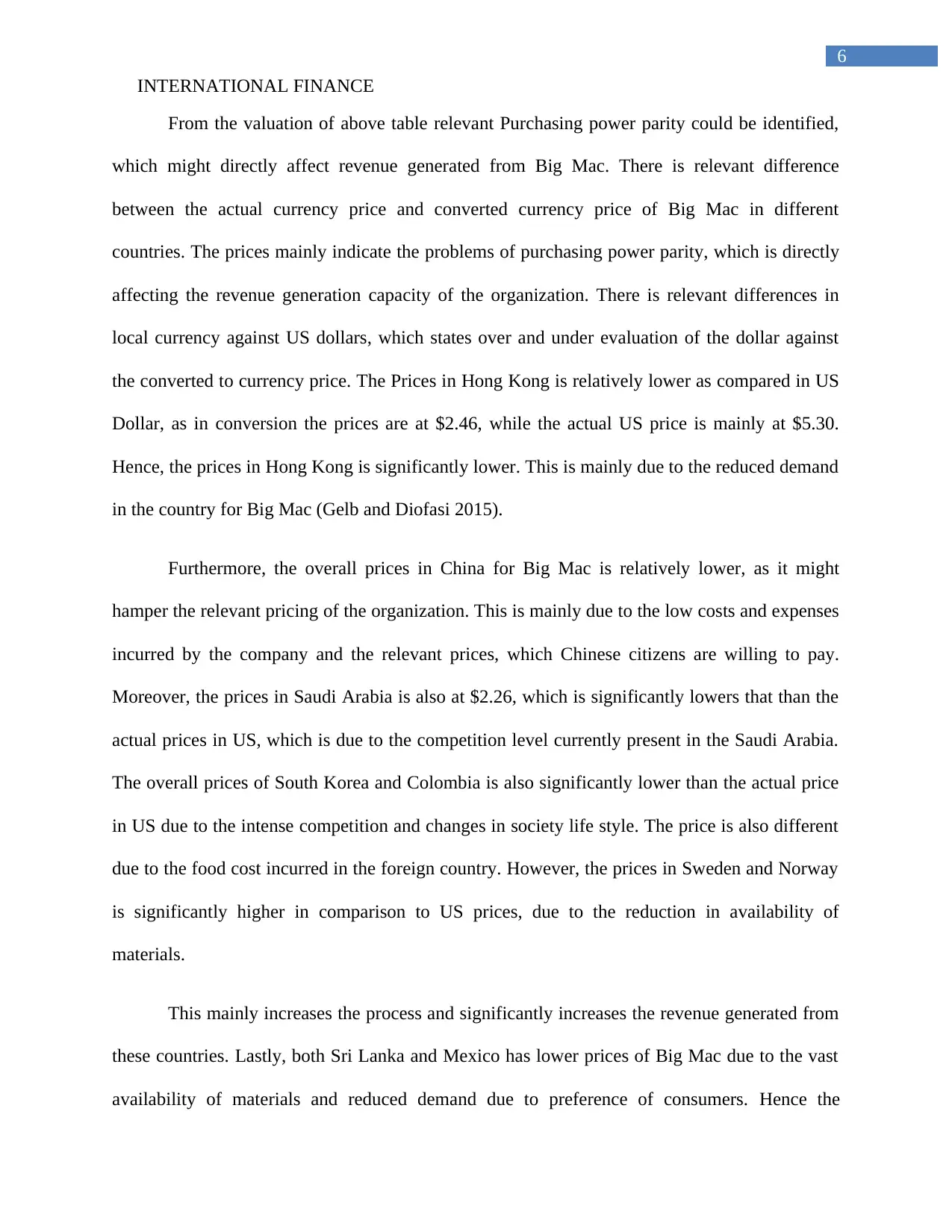
6
INTERNATIONAL FINANCE
From the valuation of above table relevant Purchasing power parity could be identified,
which might directly affect revenue generated from Big Mac. There is relevant difference
between the actual currency price and converted currency price of Big Mac in different
countries. The prices mainly indicate the problems of purchasing power parity, which is directly
affecting the revenue generation capacity of the organization. There is relevant differences in
local currency against US dollars, which states over and under evaluation of the dollar against
the converted to currency price. The Prices in Hong Kong is relatively lower as compared in US
Dollar, as in conversion the prices are at $2.46, while the actual US price is mainly at $5.30.
Hence, the prices in Hong Kong is significantly lower. This is mainly due to the reduced demand
in the country for Big Mac (Gelb and Diofasi 2015).
Furthermore, the overall prices in China for Big Mac is relatively lower, as it might
hamper the relevant pricing of the organization. This is mainly due to the low costs and expenses
incurred by the company and the relevant prices, which Chinese citizens are willing to pay.
Moreover, the prices in Saudi Arabia is also at $2.26, which is significantly lowers that than the
actual prices in US, which is due to the competition level currently present in the Saudi Arabia.
The overall prices of South Korea and Colombia is also significantly lower than the actual price
in US due to the intense competition and changes in society life style. The price is also different
due to the food cost incurred in the foreign country. However, the prices in Sweden and Norway
is significantly higher in comparison to US prices, due to the reduction in availability of
materials.
This mainly increases the process and significantly increases the revenue generated from
these countries. Lastly, both Sri Lanka and Mexico has lower prices of Big Mac due to the vast
availability of materials and reduced demand due to preference of consumers. Hence the
INTERNATIONAL FINANCE
From the valuation of above table relevant Purchasing power parity could be identified,
which might directly affect revenue generated from Big Mac. There is relevant difference
between the actual currency price and converted currency price of Big Mac in different
countries. The prices mainly indicate the problems of purchasing power parity, which is directly
affecting the revenue generation capacity of the organization. There is relevant differences in
local currency against US dollars, which states over and under evaluation of the dollar against
the converted to currency price. The Prices in Hong Kong is relatively lower as compared in US
Dollar, as in conversion the prices are at $2.46, while the actual US price is mainly at $5.30.
Hence, the prices in Hong Kong is significantly lower. This is mainly due to the reduced demand
in the country for Big Mac (Gelb and Diofasi 2015).
Furthermore, the overall prices in China for Big Mac is relatively lower, as it might
hamper the relevant pricing of the organization. This is mainly due to the low costs and expenses
incurred by the company and the relevant prices, which Chinese citizens are willing to pay.
Moreover, the prices in Saudi Arabia is also at $2.26, which is significantly lowers that than the
actual prices in US, which is due to the competition level currently present in the Saudi Arabia.
The overall prices of South Korea and Colombia is also significantly lower than the actual price
in US due to the intense competition and changes in society life style. The price is also different
due to the food cost incurred in the foreign country. However, the prices in Sweden and Norway
is significantly higher in comparison to US prices, due to the reduction in availability of
materials.
This mainly increases the process and significantly increases the revenue generated from
these countries. Lastly, both Sri Lanka and Mexico has lower prices of Big Mac due to the vast
availability of materials and reduced demand due to preference of consumers. Hence the
Paraphrase This Document
Need a fresh take? Get an instant paraphrase of this document with our AI Paraphraser
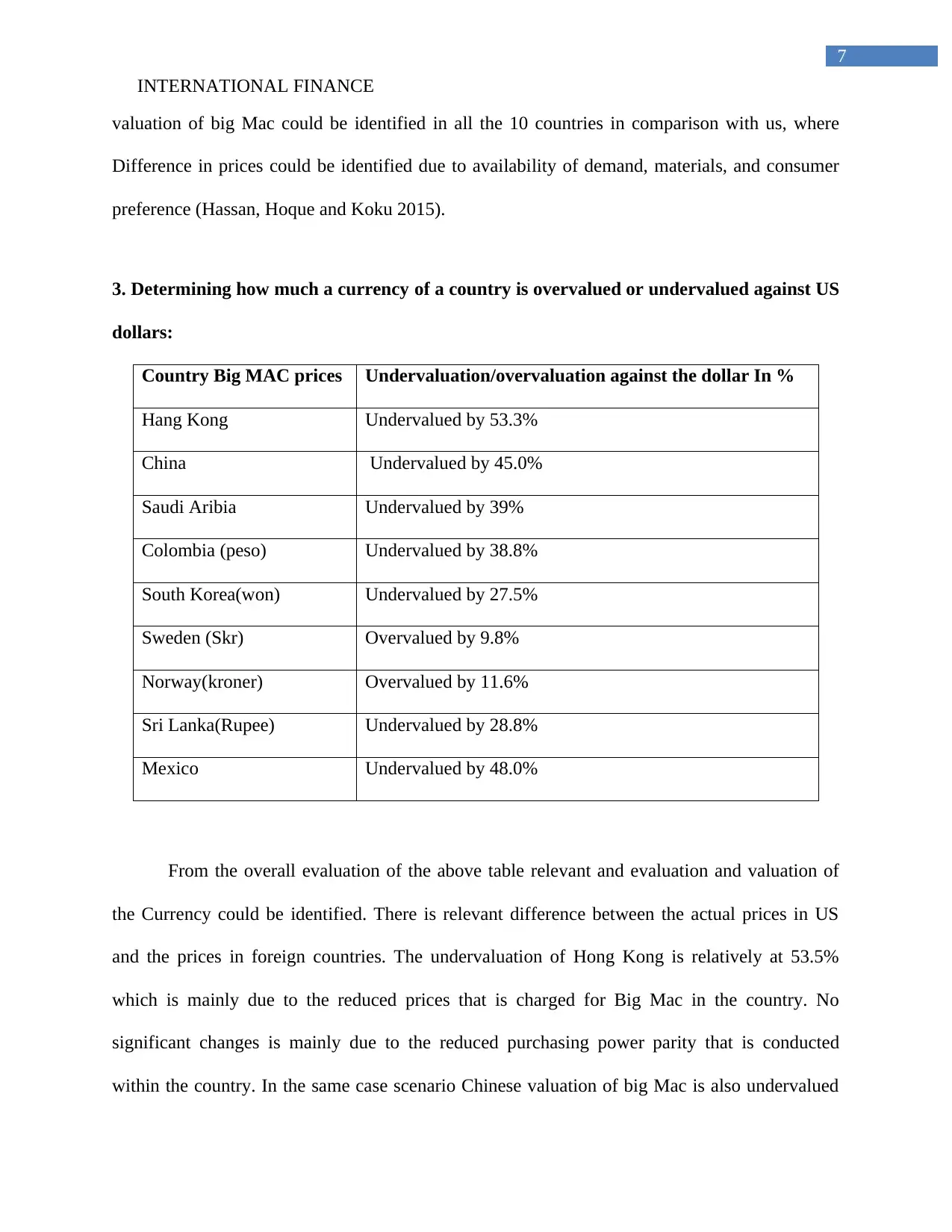
7
INTERNATIONAL FINANCE
valuation of big Mac could be identified in all the 10 countries in comparison with us, where
Difference in prices could be identified due to availability of demand, materials, and consumer
preference (Hassan, Hoque and Koku 2015).
3. Determining how much a currency of a country is overvalued or undervalued against US
dollars:
Country Big MAC prices Undervaluation/overvaluation against the dollar In %
Hang Kong Undervalued by 53.3%
China Undervalued by 45.0%
Saudi Aribia Undervalued by 39%
Colombia (peso) Undervalued by 38.8%
South Korea(won) Undervalued by 27.5%
Sweden (Skr) Overvalued by 9.8%
Norway(kroner) Overvalued by 11.6%
Sri Lanka(Rupee) Undervalued by 28.8%
Mexico Undervalued by 48.0%
From the overall evaluation of the above table relevant and evaluation and valuation of
the Currency could be identified. There is relevant difference between the actual prices in US
and the prices in foreign countries. The undervaluation of Hong Kong is relatively at 53.5%
which is mainly due to the reduced prices that is charged for Big Mac in the country. No
significant changes is mainly due to the reduced purchasing power parity that is conducted
within the country. In the same case scenario Chinese valuation of big Mac is also undervalued
INTERNATIONAL FINANCE
valuation of big Mac could be identified in all the 10 countries in comparison with us, where
Difference in prices could be identified due to availability of demand, materials, and consumer
preference (Hassan, Hoque and Koku 2015).
3. Determining how much a currency of a country is overvalued or undervalued against US
dollars:
Country Big MAC prices Undervaluation/overvaluation against the dollar In %
Hang Kong Undervalued by 53.3%
China Undervalued by 45.0%
Saudi Aribia Undervalued by 39%
Colombia (peso) Undervalued by 38.8%
South Korea(won) Undervalued by 27.5%
Sweden (Skr) Overvalued by 9.8%
Norway(kroner) Overvalued by 11.6%
Sri Lanka(Rupee) Undervalued by 28.8%
Mexico Undervalued by 48.0%
From the overall evaluation of the above table relevant and evaluation and valuation of
the Currency could be identified. There is relevant difference between the actual prices in US
and the prices in foreign countries. The undervaluation of Hong Kong is relatively at 53.5%
which is mainly due to the reduced prices that is charged for Big Mac in the country. No
significant changes is mainly due to the reduced purchasing power parity that is conducted
within the country. In the same case scenario Chinese valuation of big Mac is also undervalued
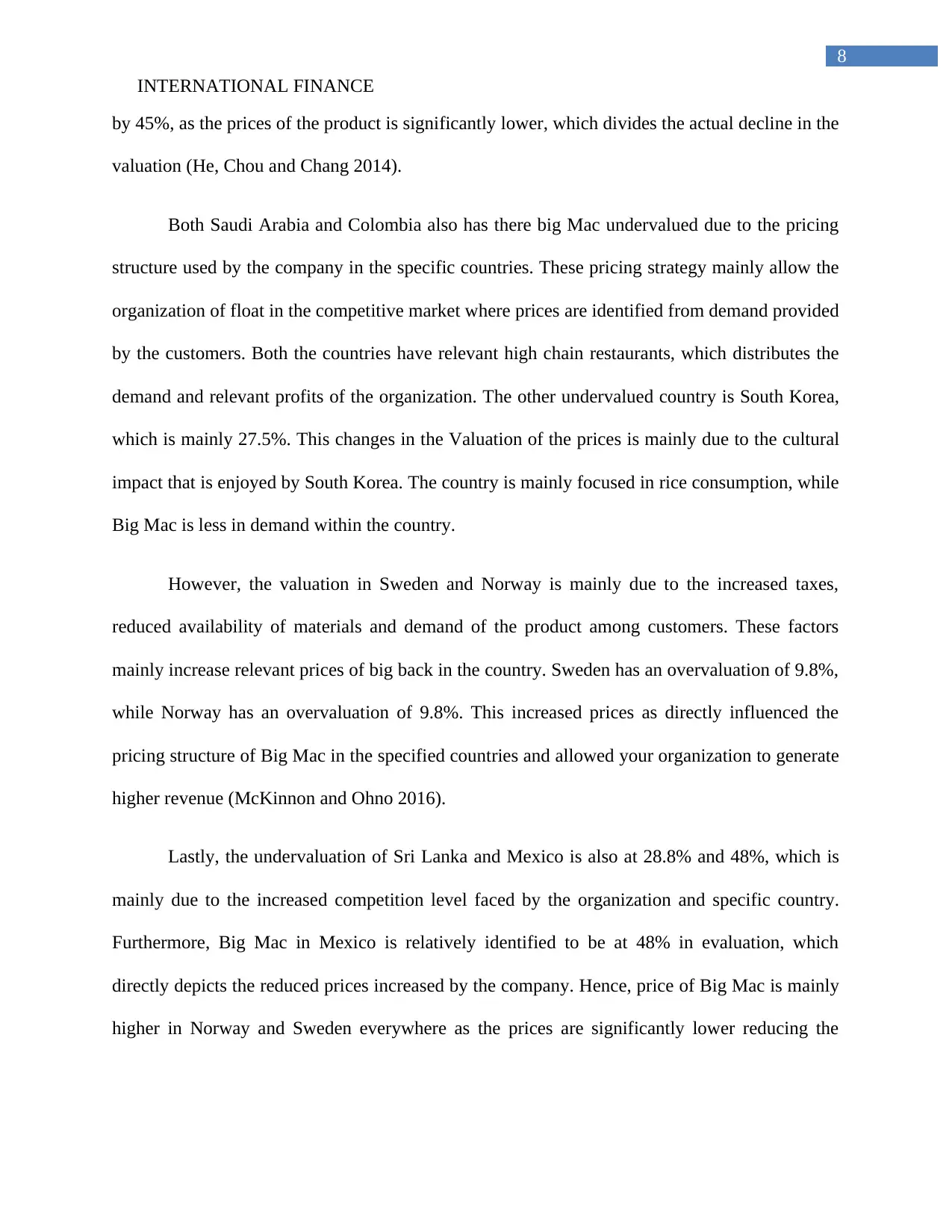
8
INTERNATIONAL FINANCE
by 45%, as the prices of the product is significantly lower, which divides the actual decline in the
valuation (He, Chou and Chang 2014).
Both Saudi Arabia and Colombia also has there big Mac undervalued due to the pricing
structure used by the company in the specific countries. These pricing strategy mainly allow the
organization of float in the competitive market where prices are identified from demand provided
by the customers. Both the countries have relevant high chain restaurants, which distributes the
demand and relevant profits of the organization. The other undervalued country is South Korea,
which is mainly 27.5%. This changes in the Valuation of the prices is mainly due to the cultural
impact that is enjoyed by South Korea. The country is mainly focused in rice consumption, while
Big Mac is less in demand within the country.
However, the valuation in Sweden and Norway is mainly due to the increased taxes,
reduced availability of materials and demand of the product among customers. These factors
mainly increase relevant prices of big back in the country. Sweden has an overvaluation of 9.8%,
while Norway has an overvaluation of 9.8%. This increased prices as directly influenced the
pricing structure of Big Mac in the specified countries and allowed your organization to generate
higher revenue (McKinnon and Ohno 2016).
Lastly, the undervaluation of Sri Lanka and Mexico is also at 28.8% and 48%, which is
mainly due to the increased competition level faced by the organization and specific country.
Furthermore, Big Mac in Mexico is relatively identified to be at 48% in evaluation, which
directly depicts the reduced prices increased by the company. Hence, price of Big Mac is mainly
higher in Norway and Sweden everywhere as the prices are significantly lower reducing the
INTERNATIONAL FINANCE
by 45%, as the prices of the product is significantly lower, which divides the actual decline in the
valuation (He, Chou and Chang 2014).
Both Saudi Arabia and Colombia also has there big Mac undervalued due to the pricing
structure used by the company in the specific countries. These pricing strategy mainly allow the
organization of float in the competitive market where prices are identified from demand provided
by the customers. Both the countries have relevant high chain restaurants, which distributes the
demand and relevant profits of the organization. The other undervalued country is South Korea,
which is mainly 27.5%. This changes in the Valuation of the prices is mainly due to the cultural
impact that is enjoyed by South Korea. The country is mainly focused in rice consumption, while
Big Mac is less in demand within the country.
However, the valuation in Sweden and Norway is mainly due to the increased taxes,
reduced availability of materials and demand of the product among customers. These factors
mainly increase relevant prices of big back in the country. Sweden has an overvaluation of 9.8%,
while Norway has an overvaluation of 9.8%. This increased prices as directly influenced the
pricing structure of Big Mac in the specified countries and allowed your organization to generate
higher revenue (McKinnon and Ohno 2016).
Lastly, the undervaluation of Sri Lanka and Mexico is also at 28.8% and 48%, which is
mainly due to the increased competition level faced by the organization and specific country.
Furthermore, Big Mac in Mexico is relatively identified to be at 48% in evaluation, which
directly depicts the reduced prices increased by the company. Hence, price of Big Mac is mainly
higher in Norway and Sweden everywhere as the prices are significantly lower reducing the
⊘ This is a preview!⊘
Do you want full access?
Subscribe today to unlock all pages.

Trusted by 1+ million students worldwide
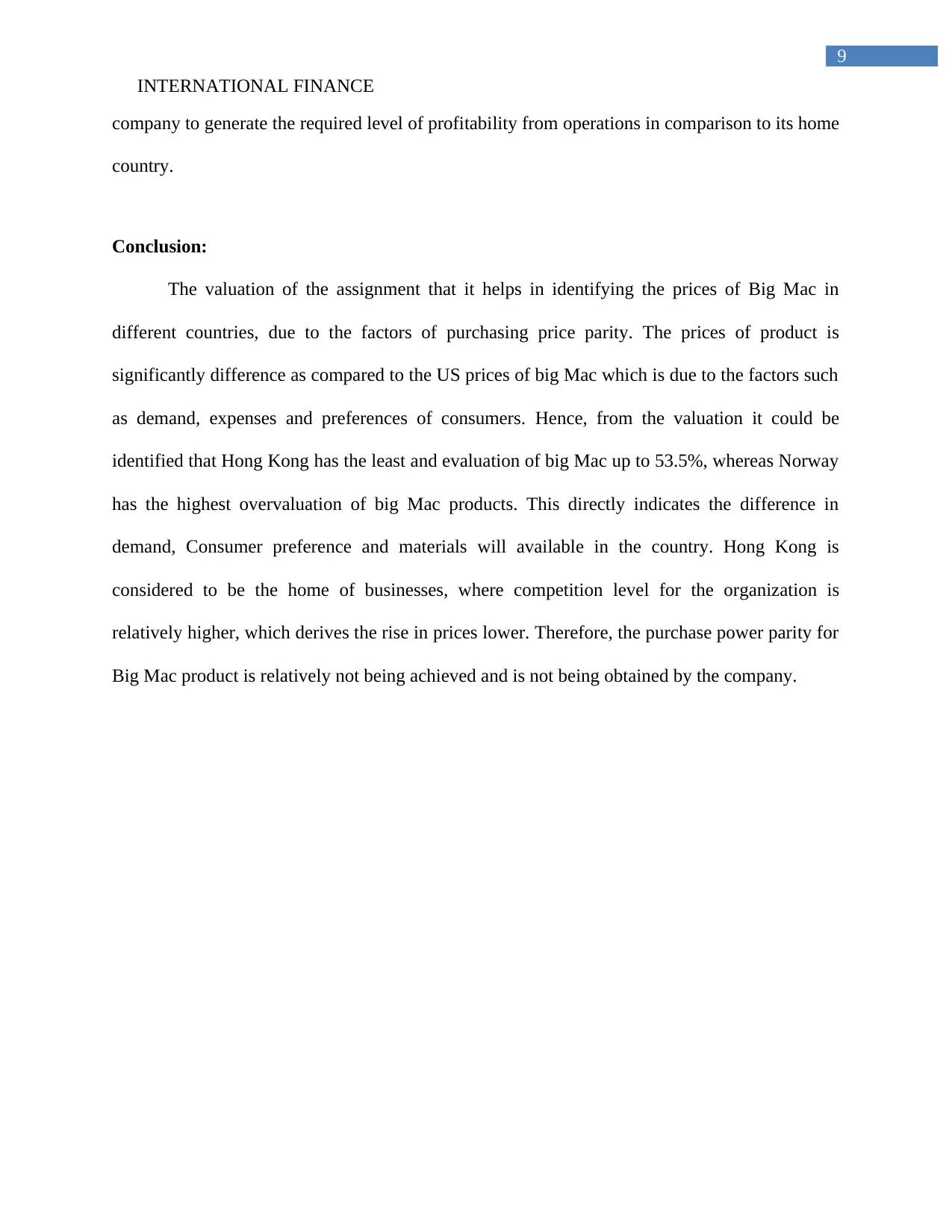
9
INTERNATIONAL FINANCE
company to generate the required level of profitability from operations in comparison to its home
country.
Conclusion:
The valuation of the assignment that it helps in identifying the prices of Big Mac in
different countries, due to the factors of purchasing price parity. The prices of product is
significantly difference as compared to the US prices of big Mac which is due to the factors such
as demand, expenses and preferences of consumers. Hence, from the valuation it could be
identified that Hong Kong has the least and evaluation of big Mac up to 53.5%, whereas Norway
has the highest overvaluation of big Mac products. This directly indicates the difference in
demand, Consumer preference and materials will available in the country. Hong Kong is
considered to be the home of businesses, where competition level for the organization is
relatively higher, which derives the rise in prices lower. Therefore, the purchase power parity for
Big Mac product is relatively not being achieved and is not being obtained by the company.
INTERNATIONAL FINANCE
company to generate the required level of profitability from operations in comparison to its home
country.
Conclusion:
The valuation of the assignment that it helps in identifying the prices of Big Mac in
different countries, due to the factors of purchasing price parity. The prices of product is
significantly difference as compared to the US prices of big Mac which is due to the factors such
as demand, expenses and preferences of consumers. Hence, from the valuation it could be
identified that Hong Kong has the least and evaluation of big Mac up to 53.5%, whereas Norway
has the highest overvaluation of big Mac products. This directly indicates the difference in
demand, Consumer preference and materials will available in the country. Hong Kong is
considered to be the home of businesses, where competition level for the organization is
relatively higher, which derives the rise in prices lower. Therefore, the purchase power parity for
Big Mac product is relatively not being achieved and is not being obtained by the company.
Paraphrase This Document
Need a fresh take? Get an instant paraphrase of this document with our AI Paraphraser
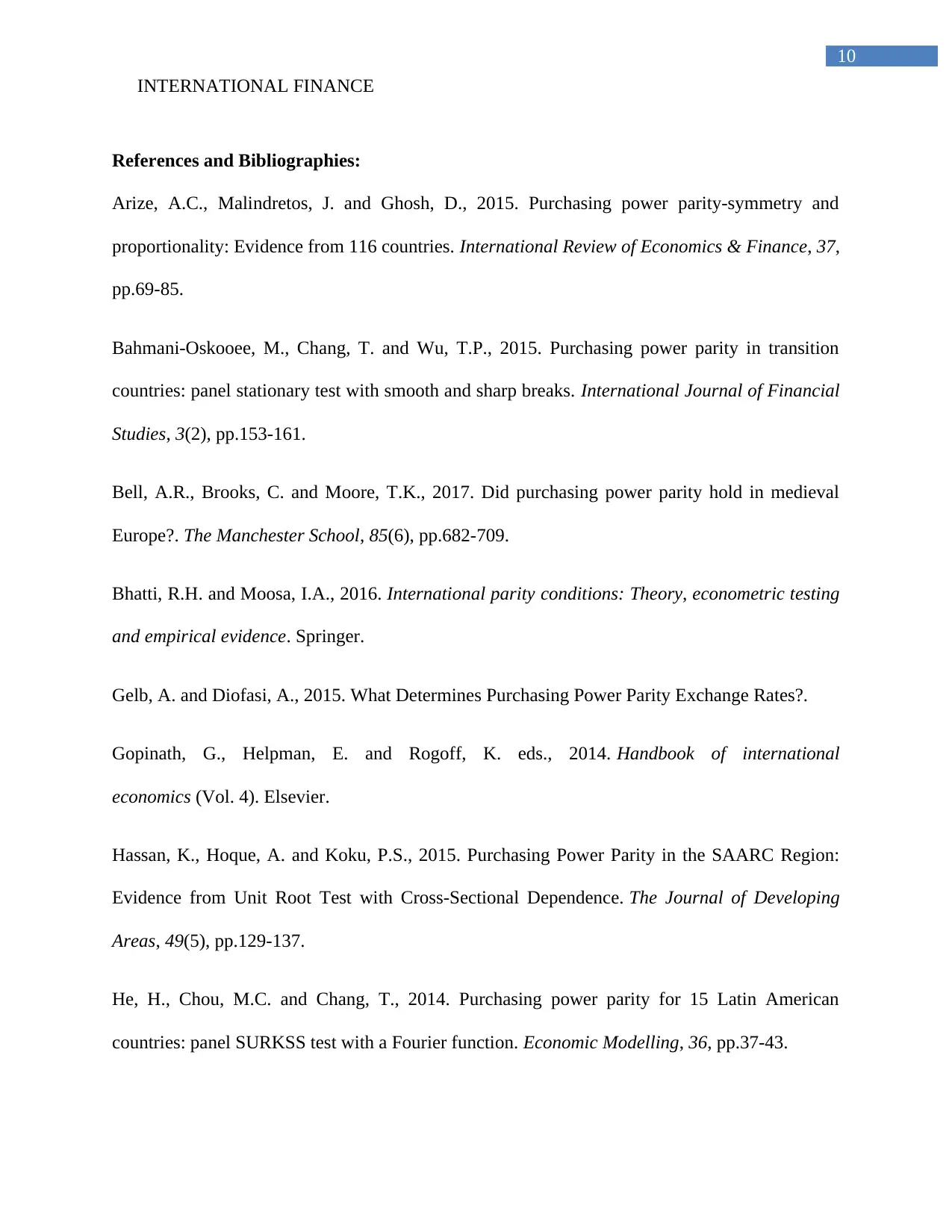
10
INTERNATIONAL FINANCE
References and Bibliographies:
Arize, A.C., Malindretos, J. and Ghosh, D., 2015. Purchasing power parity-symmetry and
proportionality: Evidence from 116 countries. International Review of Economics & Finance, 37,
pp.69-85.
Bahmani-Oskooee, M., Chang, T. and Wu, T.P., 2015. Purchasing power parity in transition
countries: panel stationary test with smooth and sharp breaks. International Journal of Financial
Studies, 3(2), pp.153-161.
Bell, A.R., Brooks, C. and Moore, T.K., 2017. Did purchasing power parity hold in medieval
Europe?. The Manchester School, 85(6), pp.682-709.
Bhatti, R.H. and Moosa, I.A., 2016. International parity conditions: Theory, econometric testing
and empirical evidence. Springer.
Gelb, A. and Diofasi, A., 2015. What Determines Purchasing Power Parity Exchange Rates?.
Gopinath, G., Helpman, E. and Rogoff, K. eds., 2014. Handbook of international
economics (Vol. 4). Elsevier.
Hassan, K., Hoque, A. and Koku, P.S., 2015. Purchasing Power Parity in the SAARC Region:
Evidence from Unit Root Test with Cross-Sectional Dependence. The Journal of Developing
Areas, 49(5), pp.129-137.
He, H., Chou, M.C. and Chang, T., 2014. Purchasing power parity for 15 Latin American
countries: panel SURKSS test with a Fourier function. Economic Modelling, 36, pp.37-43.
INTERNATIONAL FINANCE
References and Bibliographies:
Arize, A.C., Malindretos, J. and Ghosh, D., 2015. Purchasing power parity-symmetry and
proportionality: Evidence from 116 countries. International Review of Economics & Finance, 37,
pp.69-85.
Bahmani-Oskooee, M., Chang, T. and Wu, T.P., 2015. Purchasing power parity in transition
countries: panel stationary test with smooth and sharp breaks. International Journal of Financial
Studies, 3(2), pp.153-161.
Bell, A.R., Brooks, C. and Moore, T.K., 2017. Did purchasing power parity hold in medieval
Europe?. The Manchester School, 85(6), pp.682-709.
Bhatti, R.H. and Moosa, I.A., 2016. International parity conditions: Theory, econometric testing
and empirical evidence. Springer.
Gelb, A. and Diofasi, A., 2015. What Determines Purchasing Power Parity Exchange Rates?.
Gopinath, G., Helpman, E. and Rogoff, K. eds., 2014. Handbook of international
economics (Vol. 4). Elsevier.
Hassan, K., Hoque, A. and Koku, P.S., 2015. Purchasing Power Parity in the SAARC Region:
Evidence from Unit Root Test with Cross-Sectional Dependence. The Journal of Developing
Areas, 49(5), pp.129-137.
He, H., Chou, M.C. and Chang, T., 2014. Purchasing power parity for 15 Latin American
countries: panel SURKSS test with a Fourier function. Economic Modelling, 36, pp.37-43.
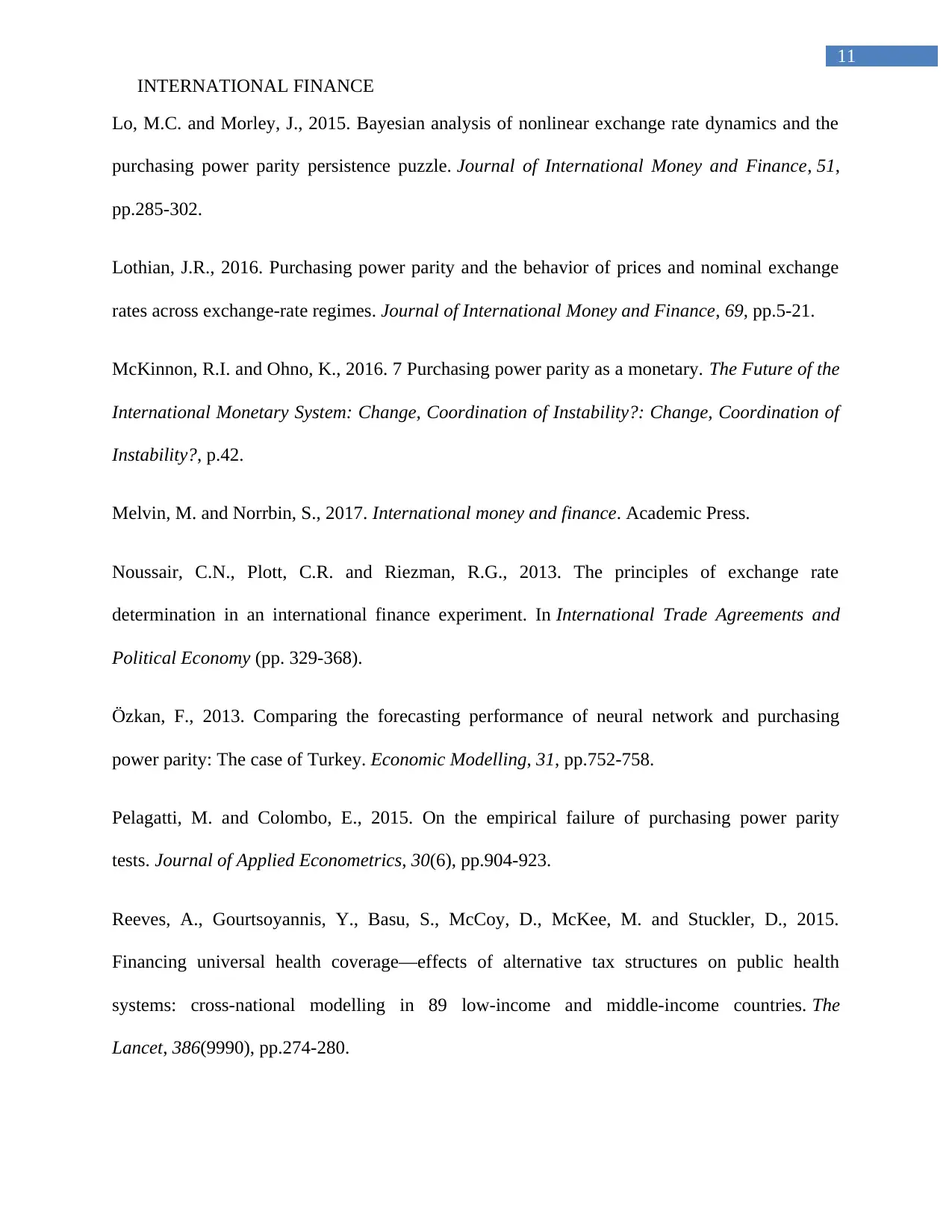
11
INTERNATIONAL FINANCE
Lo, M.C. and Morley, J., 2015. Bayesian analysis of nonlinear exchange rate dynamics and the
purchasing power parity persistence puzzle. Journal of International Money and Finance, 51,
pp.285-302.
Lothian, J.R., 2016. Purchasing power parity and the behavior of prices and nominal exchange
rates across exchange-rate regimes. Journal of International Money and Finance, 69, pp.5-21.
McKinnon, R.I. and Ohno, K., 2016. 7 Purchasing power parity as a monetary. The Future of the
International Monetary System: Change, Coordination of Instability?: Change, Coordination of
Instability?, p.42.
Melvin, M. and Norrbin, S., 2017. International money and finance. Academic Press.
Noussair, C.N., Plott, C.R. and Riezman, R.G., 2013. The principles of exchange rate
determination in an international finance experiment. In International Trade Agreements and
Political Economy (pp. 329-368).
Özkan, F., 2013. Comparing the forecasting performance of neural network and purchasing
power parity: The case of Turkey. Economic Modelling, 31, pp.752-758.
Pelagatti, M. and Colombo, E., 2015. On the empirical failure of purchasing power parity
tests. Journal of Applied Econometrics, 30(6), pp.904-923.
Reeves, A., Gourtsoyannis, Y., Basu, S., McCoy, D., McKee, M. and Stuckler, D., 2015.
Financing universal health coverage—effects of alternative tax structures on public health
systems: cross-national modelling in 89 low-income and middle-income countries. The
Lancet, 386(9990), pp.274-280.
INTERNATIONAL FINANCE
Lo, M.C. and Morley, J., 2015. Bayesian analysis of nonlinear exchange rate dynamics and the
purchasing power parity persistence puzzle. Journal of International Money and Finance, 51,
pp.285-302.
Lothian, J.R., 2016. Purchasing power parity and the behavior of prices and nominal exchange
rates across exchange-rate regimes. Journal of International Money and Finance, 69, pp.5-21.
McKinnon, R.I. and Ohno, K., 2016. 7 Purchasing power parity as a monetary. The Future of the
International Monetary System: Change, Coordination of Instability?: Change, Coordination of
Instability?, p.42.
Melvin, M. and Norrbin, S., 2017. International money and finance. Academic Press.
Noussair, C.N., Plott, C.R. and Riezman, R.G., 2013. The principles of exchange rate
determination in an international finance experiment. In International Trade Agreements and
Political Economy (pp. 329-368).
Özkan, F., 2013. Comparing the forecasting performance of neural network and purchasing
power parity: The case of Turkey. Economic Modelling, 31, pp.752-758.
Pelagatti, M. and Colombo, E., 2015. On the empirical failure of purchasing power parity
tests. Journal of Applied Econometrics, 30(6), pp.904-923.
Reeves, A., Gourtsoyannis, Y., Basu, S., McCoy, D., McKee, M. and Stuckler, D., 2015.
Financing universal health coverage—effects of alternative tax structures on public health
systems: cross-national modelling in 89 low-income and middle-income countries. The
Lancet, 386(9990), pp.274-280.
⊘ This is a preview!⊘
Do you want full access?
Subscribe today to unlock all pages.

Trusted by 1+ million students worldwide
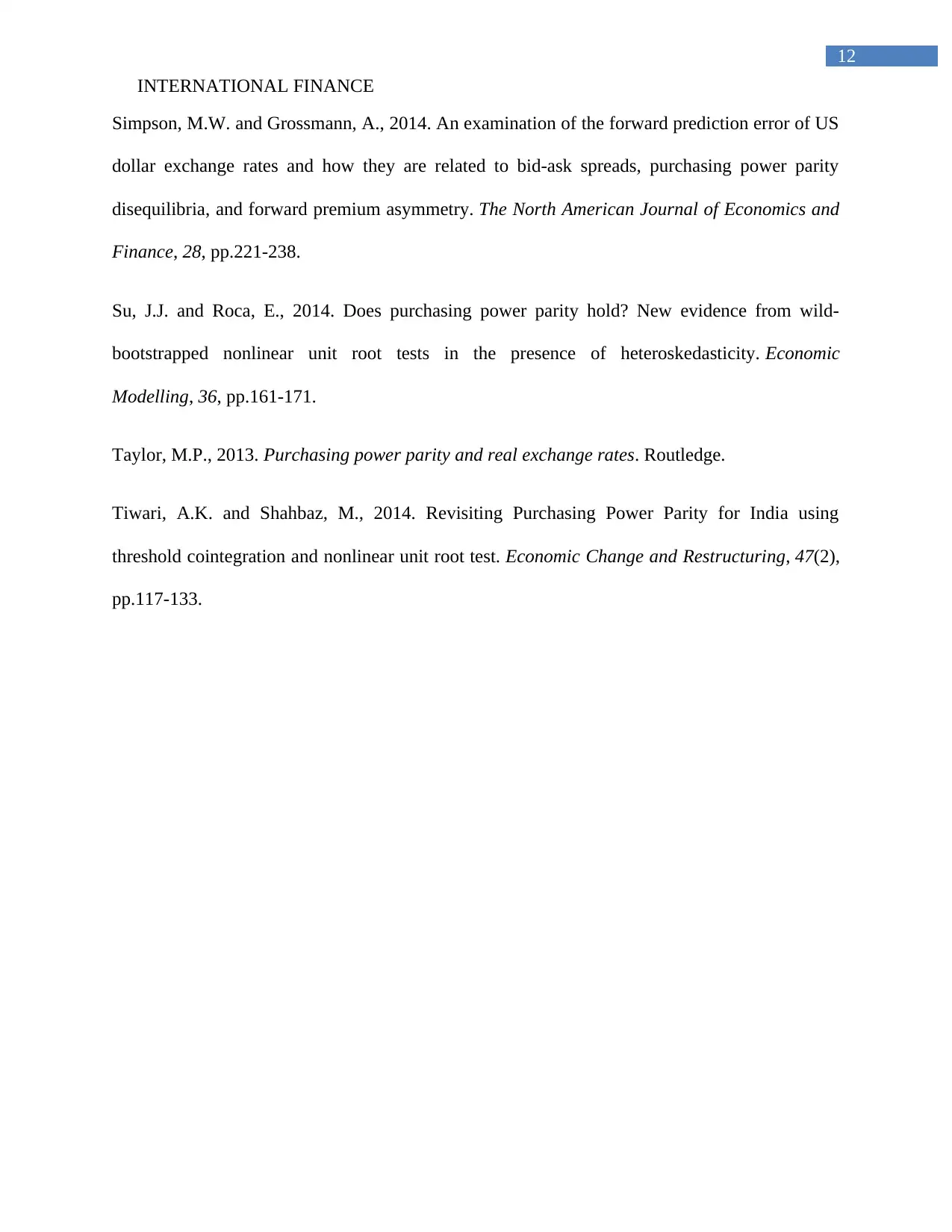
12
INTERNATIONAL FINANCE
Simpson, M.W. and Grossmann, A., 2014. An examination of the forward prediction error of US
dollar exchange rates and how they are related to bid-ask spreads, purchasing power parity
disequilibria, and forward premium asymmetry. The North American Journal of Economics and
Finance, 28, pp.221-238.
Su, J.J. and Roca, E., 2014. Does purchasing power parity hold? New evidence from wild-
bootstrapped nonlinear unit root tests in the presence of heteroskedasticity. Economic
Modelling, 36, pp.161-171.
Taylor, M.P., 2013. Purchasing power parity and real exchange rates. Routledge.
Tiwari, A.K. and Shahbaz, M., 2014. Revisiting Purchasing Power Parity for India using
threshold cointegration and nonlinear unit root test. Economic Change and Restructuring, 47(2),
pp.117-133.
INTERNATIONAL FINANCE
Simpson, M.W. and Grossmann, A., 2014. An examination of the forward prediction error of US
dollar exchange rates and how they are related to bid-ask spreads, purchasing power parity
disequilibria, and forward premium asymmetry. The North American Journal of Economics and
Finance, 28, pp.221-238.
Su, J.J. and Roca, E., 2014. Does purchasing power parity hold? New evidence from wild-
bootstrapped nonlinear unit root tests in the presence of heteroskedasticity. Economic
Modelling, 36, pp.161-171.
Taylor, M.P., 2013. Purchasing power parity and real exchange rates. Routledge.
Tiwari, A.K. and Shahbaz, M., 2014. Revisiting Purchasing Power Parity for India using
threshold cointegration and nonlinear unit root test. Economic Change and Restructuring, 47(2),
pp.117-133.
1 out of 13
Related Documents
Your All-in-One AI-Powered Toolkit for Academic Success.
+13062052269
info@desklib.com
Available 24*7 on WhatsApp / Email
![[object Object]](/_next/static/media/star-bottom.7253800d.svg)
Unlock your academic potential
© 2024 | Zucol Services PVT LTD | All rights reserved.





